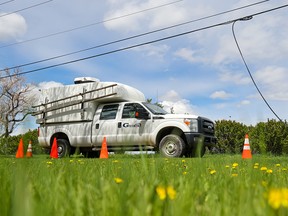‘It impacts critical telecommunications infrastructure that supports emergency services, hospitals, government, financial services and really just people’s day-to-day life’

Article content
Canadian telecommunications stakeholders are sounding alarms on copper theft, calling for steeper penalties to those that damage critical infrastructure.
Copper theft (and attempted copper theft) has been identified as a growing problem in the telecommunications industry, in some cases cutting off internet, phone and other vital services for thousands across Canada.
Advertisement 2
Article content
Two separate Rogers (previously Shaw) service outages in Calgary on May 6 and May 21 left thousands of customers without internet or phone for the better part of a day.
A key risk factor when service — particularly phone service — is lost are impacts to public safety, as some may be unable to reach emergency services.
“These acts are not victimless crimes and can have a serious impact on public safety, as well as being an inconvenience to Canadians who rely on our networks to stay connected for work, school and with friends and family,” read an emailed statement from Rogers to Postmedia.
Since 2022, Rogers has seen a four to five times increase in outages due to “vandalism” or attempted copper theft.
“Outages caused by vandalism (including attempted copper theft) are complex, repair costs and restoration times are higher, longer, and are increasing year-over year at a rapid pace,” said Rogers.

Theft and vandalism has also been on the rise for TELUS across Canada, as incidents “surged” by 68 per cent in 2023, to a total of 72 compared to 23 in 2022.
For 2024 so far, TELUS is observing numbers similar to that of 2023, according to Brian Lakey, reliability centre of excellence vice president.
Advertisement 3
Article content
“We’ve encountered 15 significant incidents affecting customers, compared to 16 in the same period for the previous year,” said Lakey.
Cable theft and damage have affected 9,500 TELUS customers so far this year, a 20 per cent increase over 2023 and 110 per cent over 2022.
Service restoration times have varied from one hour to as much as 57 hours for TELUS’ outages this year, making for an average repair time of 21 hours.
“Encouragingly, we’re seeing quicker service recovery compared to the same period last year,” Lakey said.
Calls for Criminal Code amendment, increased penalties
If perpetrators of copper theft are caught, they are typically charged with theft under $5,000, “which is the same as stealing a bicycle,” said Eric Smith, senior vice-president of the Canadian Telecommunications Association.
Smith said these types of crime have much more serious ramifications.
“It impacts critical telecommunications infrastructure that supports emergency services, hospitals, government, financial services and really just people’s day-to-day life,” he said.
Article content
Advertisement 4
Article content
Rogers said they are encouraging the Government of Canada to take action against network tampering by creating a new Criminal Code offence “specifically” targeting damage to and theft of critical telecommunications infrastructure.
TELUS is working with the federal government, looking at potentially increasing penalties according to Lakey.
“In the U.S., it’s actually considered terrorism, because you’re damaging telecommunications… a little stronger language there, we’d like to see something that sort of matches the ‘life safety’ impact of it,” Lakey said.
An amendment to the Criminal Code is among what the Canadian Telecommunications Association is calling for, said Smith.
In an emailed statement to Postmedia, the Government of Canada acknowledged the growing concern around copper theft and its impacts on communities, businesses and citizens.
“The Criminal Code prohibits intentionally damaging, destroying or committing theft of property, which could apply in situations involving telecommunications infrastructure and equipment,” the statement read.
Advertisement 5
Article content
Theft carries a maximum sentence of 10 years imprisonment when the value of what is stolen is more than $5,000. Mischief, which criminalizes the destruction, damage or interference with the lawful use, enjoyment or operation of property, including computers, carries a sentence of up to 10 years imprisonment when the value of the property exceeds $5,000.
“Proportionality in sentencing requires courts to consider the gravity of the offence (including its impact), as well as the degree of responsibility of the offender,” said the Government of Canada.
A proposed new “sabotage” offence in Bill C-70 could address copper theft in certain circumstances, where communication infrastructure is interrupted, with a maximum penalty of 10 years imprisonment.
The federal government said Bill C-70 would only apply to theft undertaken with the intent to endanger safety, security or defense of Canada, our allies’ military lawfully in Canada or if the intent is to cause a “serious risk to public health or safety”.
Smith said, “It’s really seeking to address acts that are directed at harming national interest,”
Advertisement 6
Article content
“A little bit broader, higher level than a theft or vandalism, (which) may not have that same motivation.”
Smith hopes the federal government will look within the confines of Bill C-70 to see if it can be expanded beyond acts meant to harm national interest, into any acts that harm essential infrastructure.
‘Our industry is being proactive’
Instances of copper theft can often be traced back to the price of copper itself and current economic conditions, according to Ross Johnson, security consultant for critical electricity infrastructure in Canada.
The intent of thieves, of course, is to sell the stolen copper for a profit.
“Our electricity and our telecommunications infrastructure is everywhere, and therefore it’s not manned at all times,” Johnson said. “You can’t protect everything with alarms and cameras.”
Things like aerial alarms and remote video monitoring systems have had some success, but Smith said it’s difficult to secure the “scope” of the country.
Lakey said other security steps like flood lights, fencing in certain areas and specialized locking equipment are part of the picture in deterring thieves.
Advertisement 7
Article content
“Our industry is being proactive, they are trying to take steps for themselves,” said Smith. “That means investing more money — spending more money on security, security personnel, at designated locations where risks (are) considered to be high.”
Telecommunications needs to implement non-copper substitutes for wiring that carry little to no value when recycled, Johnson said. For places where copper is a necessity, it should be marked so that if found in the recycling stream, it can be identified as stolen.
“If somebody’s stealing a lot of something… take it away from them, make sure that they don’t have access to it,” Johnson said.
TELUS and others are already doing this, as they shift to using more high-speed fibre optic cables.
From stolen copper, Johnson said thieves only get a few dollars per pound of metal. In some instances it can cost thousands — if not tens of thousands — of dollars to replace damaged infrastructure.
Replacement materials can take time to arrive and there’s also the cost of labour for repair crews, which can all potentially trickle down to customers.
Advertisement 8
Article content
In Alberta, the Scrap Metal Dealers and Recyclers Identification Act outlines duties for dealers and recyclers of scrap metal. This includes proof of identification, retaining information about the transaction, and in certain circumstances, sharing information with law enforcement agencies.
Alberta’s Critical Infrastructure Defence Act (Bill 1) identifies telecommunication lines, towers, and equipment as essential infrastructure; with fines no less than $1,000 but not exceeding $10,000 for a first offence.
Solution requires ‘multi-faceted approach’
With the industry working hard on the problem, Johnson said they could use more attention and interest from the public to help.
Lakey also mentioned that in addition to vouching for increased penalties, they’re working with the federal government on “awareness programs” to better inform people on the issue.
Const. Lorie St-Onge with the Calgary Police Service said when it comes to enforcing these instances of theft or attempted theft, the more information at their disposal — the better.
“(We’re) encouraging the general public to report suspicious behaviour,” said St-Onge. “We’re relying a bit more on video surveillance as well, because again, a picture is 1,000 words.”
Advertisement 9
Article content
People working at or near facilities should be in some form of branded vehicle, either from a provider or separate contractor.
“It’s a multi-faceted approach, say coordinating with recyclers… if they’re identifying some telecommunications wire, whatever that may look like, and then contacting police,” said St-Onge.
Another important step is making sure incident reporting is done right away, she said.
It is not clear to what extent copper theft is pre-planned, although Lakey said they believe it may take thieves a few days to set up in some cases.
Investing more money in security, stiffening penalties, regulating scrap metal buyers and public awareness are all things Smith mentioned would help.
Although there’s no central database that tracks copper theft or attempted copper theft incidents, Smith estimates there has been an increase of 200 per cent each year, over the past few years.
“Hundreds, if not over 1,000 incidences and if you look at each one, obviously the cost of repair is going to vary,” said Smith.
“We’re talking about millions of dollars being spent to repair the damage.”
Article content



